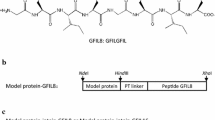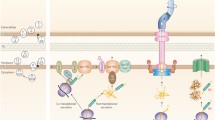Abstract
An extracellular Pseudomonas cepacia lipase, LipA, is inactive when expressed in the absence of the product of the limA gene. Evidence has been presented that LimA is a molecular chaperone. The lipA and limA genes have been cloned in separate and independently inducible expression systems in Escherichia coli. These systems were used to test the molecular chaperone hypothesis by investigating whether LimA could activate presynthesized prelipase and whether presynthesized LimA could activate newly synthesized prelipase. The results show that LimA cannot activate presynthesized prelipase and that presynthesized LimA can activate only a limited number of de novo synthesized prelipase molecules. Co-immunoprecipitation of prelipase/lipase with LimA generated a 1:1 complex of prelipase/lipase and LimA. The results suggest that a 1:1 complex of LipA and LimA is required for prelipase processing and secretion of active lipase.
Similar content being viewed by others
References
Anfinsen CB, Haber E, Sela M, White FH (1961) The kinetics of formation of native ribonuclease during oxidation of the reduced polypeptide chain. Proc Natl Acad Sci USA 47:1309–1314
Bjerrum OJ, Heegaard NH (1987) Handbook of immunoblotting of proteins. CRC Press, Boca Raton, Fla
Chang ACY, Cohen SN (1978) Construction and amplification of amplifiable multicopy DNA cloning vehicles derived from the p15A cryptic miniplasmid. J Bacteriol 134:1141–1156
Chihara-Siomi M, Yoshikawa K, Oshima-Hirayama N, Yamamoto K, Sogabe Y, Nakatani T, Nishioka T, Oda J (1992) Purification, molecular cloning, and expression of lipase from Pseudomonas aeruginosa. Arch Biochem Biophys 296:505–513
Clarke L, Carbon J (1978) Functional Expression of Cloned Yeast DNA in Escherichia coli: Specific Complementation of Argininosuccinate Lyase (argH) Mutations. J Mol Biol 120:517–534
Ellis RJ, van der Vies SM (1991) Molecular chaperones. Annu Rev Biochem 60:321–347
Frenken LGJ, Bos JW, Visser C, Muffler W, Tommassen J, Verrips CT (1993a) An accessory gene, lipB, required for the production of active Pseudomonas glumae lipase. Mol Microbiol 9:579–589
Frenken LGJ, de Groot A, Tommassen J, Verrips CT (1993b) Role of the lipB, gene product in the folding of the secreted lipase of Pseudomonas glumae. Mol Microbiol 9:591–599
Georgopoulos C (1992) The emergence of the chaperone machines. Trends Biochem Sci 17:295–299
Gething MJ, Sambrook J (1992) Protein folding in the cell. Nature 355:33–45
Gibson TJ (1984) Studies on the Epstein-Barr virus genome. PhD thesis, Cambridge University, UK
Gormley E, Cantwell BA, Barker PJ, Gilmour RS, McConnell DJ (1988) Secretion and processing of the Bacillus subtilis endo-β-1,3-1,4-glucanase in E. coli. Mol Microbiol 2:813–819
Hastrup S (1988) Analysis of the Bacillus subtilis xylose regulon. In: Zukowski, Ganesan, Hoch (eds), Genetics and biotechnology of Bacilli, vol 2. Academic Press, San Diego, pp 79–83
Hastrup S, Jacobs MF (1990) Lethal phenotype conferred by xylose-induced overproduction of an apr-lacZ fusion protein. In: Zukowski, Ganesan and Hoch (eds), Genetics and biotechnology of Bacilli, vol 3. Academic Press, San Diego, pp 33–41
Hobson AH, Buckley CM, Aamand JL, Jørgensen S, Diderichsen B, McConnell DJ (1993) Activation of a bacterial lipase by its chaperone. Proc Natl Acad Sci USA 90:5682–5686
Ihara F, Okamoto I, Nihira T, Yamada Y (1992) Requirement in trans of the downstream limL gene for activation of lactonizing lipase from Pseudomonas sp. 109. J Ferment Bioeng 73:337–342
Itzumi T, Nakamura K, Shimada Y, Sugihara A, Tominaga Y, Fukase T (1991) Cloning, nucleotide sequencing, and expression in Escherichia coli of a lipase and its activator genes from Pseudomonas sp. KWI-56. Agric Biol Chem 55:2349–2357
Jørgensen PL, Hansen CK, Poulsen GB, Diderichsen B (1990) In vivo genetic engineering: homologous recombination as a tool for plasmid construction. Gene 96:37–41
Jørgensen S, Skov KW, Diderichsen B (1991) Cloning, sequence, and expression of a lipase gene from Pseudomonas cepacia: lipase production in heterologous hosts requires two Pseudomonas genes. J Bacteriol 173:559–567
Kumamoto CA, Francetic O (1993) Highly selective binding of nascent polypeptides by an Escherichia coli chaperone protein in vivo. J Bacteriol 175:2184–2188
Kusukawa N, Yura T, Ucguchi C, Akiyama Y, Ito K (1989) Effects of mutations in heat-shock genes groES and groEL on protein export in Escherichia coli. EMBO J 8:3517–3521
Lecker S, Lill R, Ziegelhoffer T, Georgopoulos C, Bassford, P Jr, Kumamoto CA, Wickner W (1989) Three pure chaperone proteins of Escherichia coli - SecB, Trigger Factor and GroEL - form soluble complexes with precursor proteins in vitro. EMBO J 8:2703–2709
Mandel A, Higa A (1970) Calcium-dependent bacteriophage DNA Infection. J Mol Biol 53:159–162
Martin J, Mayhew M, Langer T, Hartl FU (1993) The reaction cycle of GroEL and GroES in chaperonin-assisted protein folding. Nature 366:228–233
Nakanishi Y, Watanabe H, Washizu K, Narahashi Y, Kurono Y (1991) Cloning, sequencing and regulation of the lipase gene from Pseudomonas sp. M-12-33. In: Alberghina, Schmid and Verger (eds) Lipases: structure, mechanism and genetic engineering. GBF Monographs, Braunschweig, Germany, 263–266
Ortlepp SA, Ollington JF, McConnell DJ (1983) Molecular cloning in Bacillus subtilis of a Bacillus licheniformis gene encoding a thermostable a-amylase. Gene 23:267–276
Oshima-Hirayama N, Yoshikawa K, Nishioka T, Oda J (1993) Lipase from Pseudomonas aeruginosa. Production in Escherichia coli and activation in vitro with a protein from the downstream gene. Eur J Biochem 215:239–246
Power SD, Adams RM, Wells JA (1986) Secretion and autoproteolytic maturation of subtilisin. Proc Natl Acad Sci USA 83:3096–3100
Sambrook J, Fritsch EF, Maniatis T (1989) Molecular cloning: a laboratory manual, 2nd edn. Cold Spring Harbor Laboratory Press, Cold Spring Harbor, New York
Schröder H, Langer T, Hartl F-U, Bukau B (1993) DnaK, DnaJ and GrpE form a cellular chaperone machinery capable of repairing heat-induced protein damage. EMBO J 12:4137–4144
Studier FW, Rosenberg AH, Dunn JJ, Dubendorff JW (1990) Use of T7 RNA polymerase to direct expression of cloned genes. Methods Enzymol 185:60–89
Terhorst C, van Agthoven A, LeClair K, Snow P, Reinherz E, Schlossman S (1981) Biochemical studies of the human thymocyte cell-surface antigens T6, T9, and T10. Cell 23:771–780
Tolleshaug H, Goldstein JL, Schneider WJ, Brown MS (1982) Post-translational processing of the LDL receptor and its genetic disruption in familial hypercholesterolemia. Cell 30:715–724
Wohlfarth S, Hoesche C, Strunk C, Winkler UK (1992) Molecular genetics of the extracellular lipase of Pseudomonas aeruginosa PAO1. J Gen Microbiol 138:1325–1335
Yanisch-Perron C, Vieira J, Messing J (1985) Improved M13 phage cloning vectors and host strains: nucleotide sequence of the M13mpl8 and pUC19 vectors. Gene 33:103–119
Yasbin RE, Wilson GA, Young FE (1975) Transformation and transfection in lysogenic strains of Bacillus subtilis: evidence for selective induction of prophage in competent cells. J Bacteriol 121:296–304
Zhu X, Ohta Y, Jordan F, Inouye M (1989) Pro-sequence of subtilisin can guide the refolding of denatured subtilisin in an intermolecular process. Nature 339:483–484
Author information
Authors and Affiliations
Additional information
Communicated by C.P. Hollenberg
Rights and permissions
About this article
Cite this article
Aamand, J.L., Hobson, A.H., Buckley, C.M. et al. Chaperone-mediated activation in vivo of a Pseudomonas cepacia lipase. Molec. Gen. Genet. 245, 556–564 (1994). https://doi.org/10.1007/BF00282218
Received:
Accepted:
Issue Date:
DOI: https://doi.org/10.1007/BF00282218




